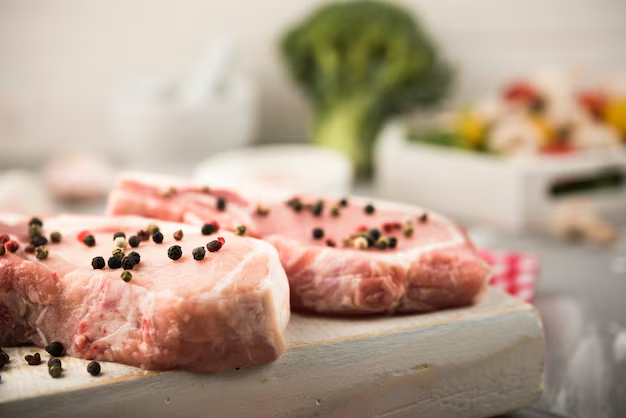Unlocking the Secret to Aging Steaks at Home: A Comprehensive Guide
Imagine this: a beautifully marbled steak, tender and flavorful, with a rich depth that sets it apart from the ordinary. Many gourmet lovers dream of achieving such taste, and the secret lies in the art of steak aging. While traditionally conducted in professional settings, you can unlock this culinary secret at home. Aging steaks in the refrigerator might seem daunting, but with careful preparation and understanding, it can be a rewarding journey. Let's explore the steps, considerations, and nuances of aging steaks at home.
What is Steak Aging?
Steak aging is a process that enhances the flavor and tenderness of beef. There are two primary methods: dry aging and wet aging. Here's a closer look at each:
Dry Aging vs. Wet Aging
Dry Aging: This involves hanging whole beef parts in a controlled, chilled environment. Over weeks, natural enzymes break down muscle tissue, enhancing tenderness. The exterior develops a crust that is trimmed before cutting into steaks. The result? A deep, complex flavor and melt-in-the-mouth texture.
Wet Aging: In contrast, wet aging involves vacuum-sealing meat in its juices. This method is faster and less intense, providing a milder flavor profile compared to its dry counterpart.
While professional butchers might opt for these methods in specialized conditions, some enthusiasts have successfully adapted dry aging to a home setting.
Preparing for Home Aging: What You Need
Equipment Essentials
Before diving into the aging process, ensure you have these essentials ready:
Quality Meat: Begin with a high-quality cut, preferably a whole ribeye or striploin. Bone-in cuts work well, but boneless options are also suitable.
Dedicated Refrigerator or Aging Box: Ideal conditions are critical. A separate fridge or aging box maintains the consistent temperature and humidity needed without contaminating other foods.
Wire Rack and Baking Sheet: These allow air circulation around the meat, crucial for proper aging.
Salt: Adds a protective barrier to the meat and enhances flavor.
Setting the Stage: Conditions Matter
The environment is key in dry aging. Target a consistent temperature of around 34–38°F (1–3°C) and humidity levels between 80–85%. These settings discourage harmful bacterial growth while allowing beneficial microorganisms to enhance the meat.
Step-by-Step Guide to Aging Steaks
1. Prepare the Meat:
Pat the Meat Dry: Moisture on the surface can lead to spoilage. Use paper towels to ensure the meat is thoroughly dry.
Seasoning: Generously coat the exterior with salt, creating a protective crust and enhancing flavor.
2. Set Up the Aging Space:
Wire Rack Placement: Place the meat on a wire rack over a baking sheet. This setup ensures airflow and catches any dripping.
Spacing: Allow space around the meat for uniform air circulation.
3. Monitor the Conditions:
Temperature Check: Verify temperature consistently resides between 34–38°F to prevent spoilage.
Humidity Levels: Invest in a hygrometer to monitor and adjust humidity within the ideal range.
4. The Waiting Game:
The aging process isn’t for the impatient. Generally, aging lasts from two weeks to several months. Each duration offers unique benefits:
- 2-4 weeks: Mild aroma and tenderness development.
- 4-6 weeks: Enhanced earthy flavors with a deeper aroma.
- 6+ weeks: Intense beef flavors and distinct taste profile.
5. Final Touches:
After aging, trim away the hardened outer crust. Slice into steaks, and you're ready to cook your masterpiece.
Practical Tips and Troubleshooting
Common Challenges and Solutions
Odor Concerns: A robust, earthy scent is normal; however, any sour or unpleasant smell indicates spoilage. Discard steak immediately if this occurs.
Mold Formation: Some mold on the surface is normal and can be trimmed away. However, if growth is excessive or unusual, consider discarding the meat.
Best Practices
Consistent Monitoring: Regularly check conditions. Make adjustments as necessary to maintain optimal temperature and humidity.
Hygiene: Cleanliness is crucial. Ensure all surfaces and equipment are sanitized to avoid contamination.
Understanding and Embracing the Flavor:
The Unique Taste of Aged Steaks
Aging transforms the meat's natural flavors, providing a robust, nutty essence. Cooking enhances these flavors, offering a gourmet experience unparalleled by conventionally purchased steaks.
Serving the Perfect Aged Steak
Cooking Methods: Simplicity is key. Use methods like grilling or pan-searing to enhance the steak's natural flavors without overpowering them.
Pairing and Presentation: Pair with complementary sides, such as roasted vegetables or simple potatoes, allowing the steak's richness to remain the star of the meal.
Safety and Considerations
Key Takeaways for Safe Aging
- Consistency is Vital: Maintain the right conditions to ensure a safe aging process.
- Trust Your Senses: Use smell and visual inspection as guides. If anything seems off, err on the side of caution.
The Logic of Patience
Patience is not merely a virtue in steak aging — it's a necessity. Each day contributes to developing a depth of flavor that's well worth the wait.
Visual Summary: Key Steps to Home-Aging 🥩
🔍 Choose Quality Meat:
- Opt for larger cuts like ribeye.
- Verify freshness before starting.
📊 Prepare Your Environment:
- Maintain 34–38°F temperature.
- Ensure 80–85% humidity.
🚦 Start Dry Aging:
- Dry, salt, and rack the meat.
- Monitor conditions regularly.
⏳ Wait, Watch, and Taste:
- Age 2–6 weeks for desired flavor.
- Trim, slice, and enjoy your creation!
The culinary journey from aging steak in your refrigerator delivers an unmatched reward of flavors. As you master this art, remember: the process is as much about science as it is about patience and care. Transforming ordinary meat into a gourmet delight can turn an adventurous task into an inspiring hobby, elevating your culinary skills to new heights.
